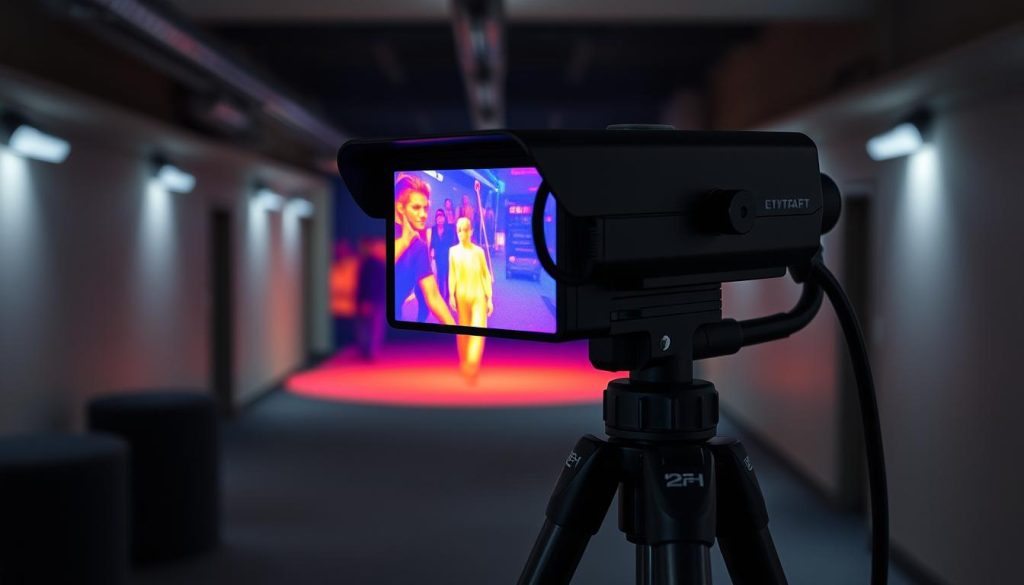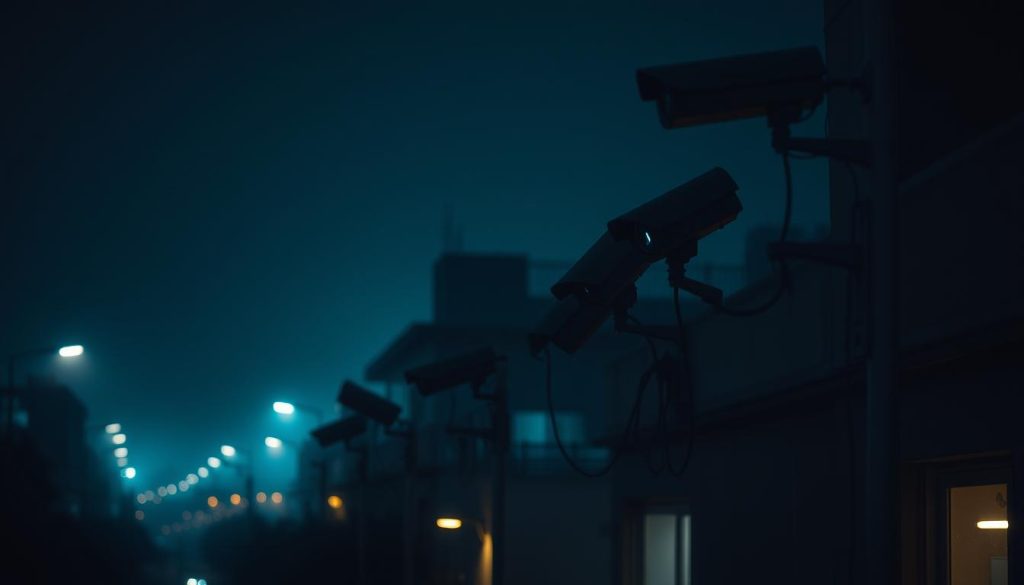In today’s fast-changing security world, how well CCTV cameras work in the dark is key. This is true in cities like Singapore, where night activities raise security risks. Knowing how these systems handle low light is vital. This article looks into night vision tech and its part in keeping us safe at all hours.
Key Takeaways
- CCTV cameras can effectively capture footage in dark conditions using night vision technology.
- Understanding various types of night vision can enhance surveillance strategies.
- Infrared technology is key for CCTV to work well in low light.
- Thermal imaging is a strong option for nighttime security.
- Placing cameras right can really boost video quality.
- Keeping cameras in good shape and updating software is critical for best performance.
Understanding Night Vision Technology
Learning about night vision technology is key for better security systems. It uses infrared light, which we can’t see, to let security cameras see in the dark. At the heart of this tech are CMOS and CCD sensors. They are vital for making images clear at night.
How Night Vision Works
Night vision tech mainly catches infrared light. Cameras with this tech turn infrared into images we can see. They use special electronics and CMOS or CCD sensors to do this. These sensors help us see things even when it’s pitch black.
Types of Night Vision Technology
There are two main types of night vision tech used in surveillance. The first is infrared night vision, which uses infrared LEDs to light up dark spots. The second is thermal imaging, which spots objects by their heat, even in very little light. Both types have their own benefits, meeting different security needs.
Can CCTV Work in Dark?
Surveillance in complete darkness is a big challenge. It’s key to know how infrared tech boosts CCTV systems in dark places. Many CCTV systems with infrared can work well even without visible light.
Infrared Technology for Low-Light Conditions
Infrared tech lets cameras see in very dark places. These cameras use infrared bulbs to light up scenes. This light is not seen by our eyes but helps create clear images.
This light makes it possible to see details in the dark. It’s a big help for security teams at night. Infrared CCTV is a vital tool for them.
Limitations of Standard CCTV Cameras at Night
Regular CCTV cameras don’t do well in dark. They need visible light to work, which is missing in dark places. This makes their images blurry and hard to make out.
This problem makes it hard to identify people or what’s happening. The need for night vision tech is clear. It ensures we can watch over places reliably, day or night.
Comparing Night Vision and Standard Cameras
When looking at surveillance options for dark places, the gap between night vision cameras and standard cameras is clear. Night vision cameras are made for the dark, making them better in low light. Standard cameras have trouble showing clear images in the dark, leading to blurry footage.
Knowing these differences helps pick the best tech for watching over areas.
Performance in Low-Light Environments
Night vision cameras shine in dark spots thanks to infrared tech. This tech turns invisible light into visible images. So, they can show clear pictures even in very dark places.
On the other hand, standard cameras need light to work well. They don’t do well in dark places. If you need to watch over dark areas, night vision cameras are the better choice.
Image Quality Differences
Night vision cameras make much clearer images in the dark than standard cameras. They keep details sharp in different light levels. This means no more fuzzy, unclear footage.
If you want better security, learning about the image quality differences between these cameras can help you make a smart choice.
The Role of Infrared LEDs in CCTV Cameras
Infrared LEDs are key in making CCTV cameras work well, even in dark places. They send out infrared light, which cameras can see but we can’t. This helps cameras work better, keeping us safe in many situations.
How Infrared LEDs Illuminate Dark Areas
In the dark, infrared LEDs are like magic lights for CCTV cameras. They shine invisible light that lets cameras see clearly. This is super important for cameras to work well in the dark, making them a big help in keeping us safe.
Visible Signs of Infrared Technology in Cameras
Cameras with infrared LEDs have small red lights around their lenses. These lights show that the camera can see in the dark. Seeing these lights means the camera is ready to handle any lighting, helping keep us safe.
External Lighting Solutions for CCTV
Effective surveillance often relies on external lighting to enhance CCTV systems, mainly at night. Adequate ambient light makes recorded footage clearer and more visible. This section explores how to use external lighting to boost CCTV performance and tackle surveillance challenges.
Using Ambient Light to Enhance Surveillance
Adding external lighting to a surveillance setup can make monitoring more effective. Some useful lighting solutions include:
- Using nearby street lights to illuminate the area under observation
- Installing motion sensor lights that activate when movement is detected
- Using LED floodlights to create bright spots that enhance visibility
These options can significantly reduce the risk of poorly lit footage. They help surveillance cameras capture clearer images, making it easier to identify individuals and events.
Potential Challenges with External Lighting
While external lighting offers many benefits, it also has challenges. Common issues include:
- Obstructions such as trees or buildings that can block light and create shadows
- Glare from powerful light sources, which can hinder the camera’s ability to focus properly
- Excessive light that may wash out details, making it difficult to discern critical features in the footage
It’s important to address these challenges to ensure that ambient light improves CCTV effectiveness and security.
Thermal Imaging: A Superior Alternative
Thermal imaging technology is a strong tool for security. It beats traditional night vision in many ways. It uses infrared energy, not visible light, to see in complete darkness.
This makes it great for places where finding temperature is key.
Principles of Thermal Imaging Technology
Thermal imaging works by finding heat differences. Every object gives off infrared energy based on its heat. Cameras turn this energy into images, showing temperature variations.
This lets security teams spot warm bodies or hot machinery, even in dark places.
Applications of Thermal Imaging in Security
Thermal imaging is used in many security areas. Here are some examples:
- Watching over sensitive spots like military bases and key buildings.
- Checking borders and coastlines for illegal entries.
- Finding intruders in businesses at night, without needing lights.
- Keeping an eye on industrial sites for temperature issues, to avoid fires.
These uses show thermal imaging’s power. It’s a better choice than old ways of watching over places. Its ability to work in the dark is very useful for keeping areas safe.

Best Practices for Installing Night Vision CCTV
Installing CCTV systems is key for top-notch security, more so in dark places. The success of night vision systems relies on smart camera placement and clear views. By following best practices, you can ensure thorough monitoring of homes and businesses.
Strategic Placement of Cameras
Deciding where to put cameras needs careful thought. Aim for busy spots and entry points for the best coverage. For example, cameras at entrances, driveways, or windows boost security.
Ensuring Unobstructed Views
To get the most out of your system, keep cameras free from blockages. Trees, walls, or decorations can ruin the view. Make sure the lenses are clear to capture everything. This way, you get a full view of the area, helping spot threats.
For tips on checking your CCTV at night, see this guide. Proper installation and planning lead to better safety and peace of mind.
Tips for Maintaining Night Vision Cameras
Keeping night vision cameras working well is all about regular care. By following some key tips, you can make them last longer and work better. Cleaning them often and updating their software are the best ways to do this.
Regular Cleaning and Inspection
Cleaning is key to keeping night vision cameras clear and working right. Dust and dirt can block the view. Regular checks also help spot problems with power and camera performance early.
Here are some cleaning and checking tips:
- Gently wipe the camera lenses with a soft, lint-free cloth to remove dirt or smudges.
- Inspect housing for any signs of damage or wear.
- Check alignment and positioning of the cameras regularly.
Software Updates and Firmware Checks
It’s important to keep your night vision cameras up to date with the latest software. Updates add new features and fix bugs. Regular checks for firmware updates keep your system ready for new threats.
Here’s how to stay updated:
- Access the camera’s network settings to check for available updates.
- Regularly monitor the manufacturer’s website or app for software announcements.
- Implement updates promptly to ensure your system performs at its best.
Choosing the Right CCTV System for Nighttime Surveillance
When picking CCTV systems for nighttime use, several key factors matter a lot. Camera resolution is one of them. Higher resolution means clearer images, which are key for spotting people or details in the dark. Also, checking the infrared capabilities of cameras is important. Good infrared tech lets you see better in complete darkness, making your security better.
Another important thing is the extra features, like IR illuminators. These help a lot with seeing at night, even when it’s very dark. Look for systems that fit your needs now and can grow with your security setup. This way, you get full coverage and better protection for your place.
Getting the right CCTV system for nighttime gives you peace of mind. Look at camera features, infrared, and how well they work together. This helps you choose wisely and keep your property safe. Thinking about these points helps build a strong surveillance plan that lasts and boosts your security.

